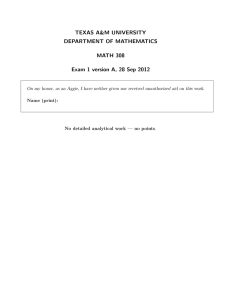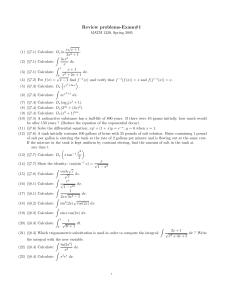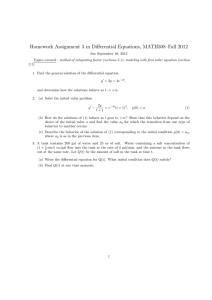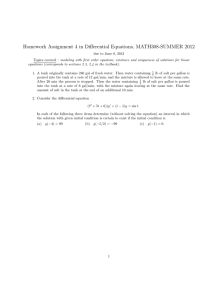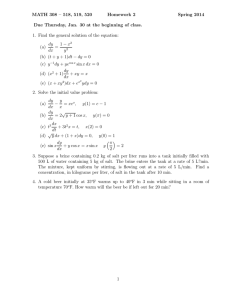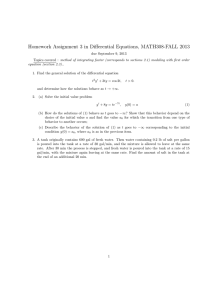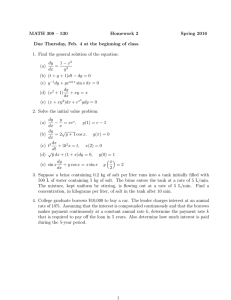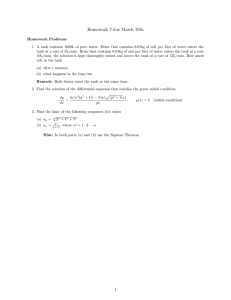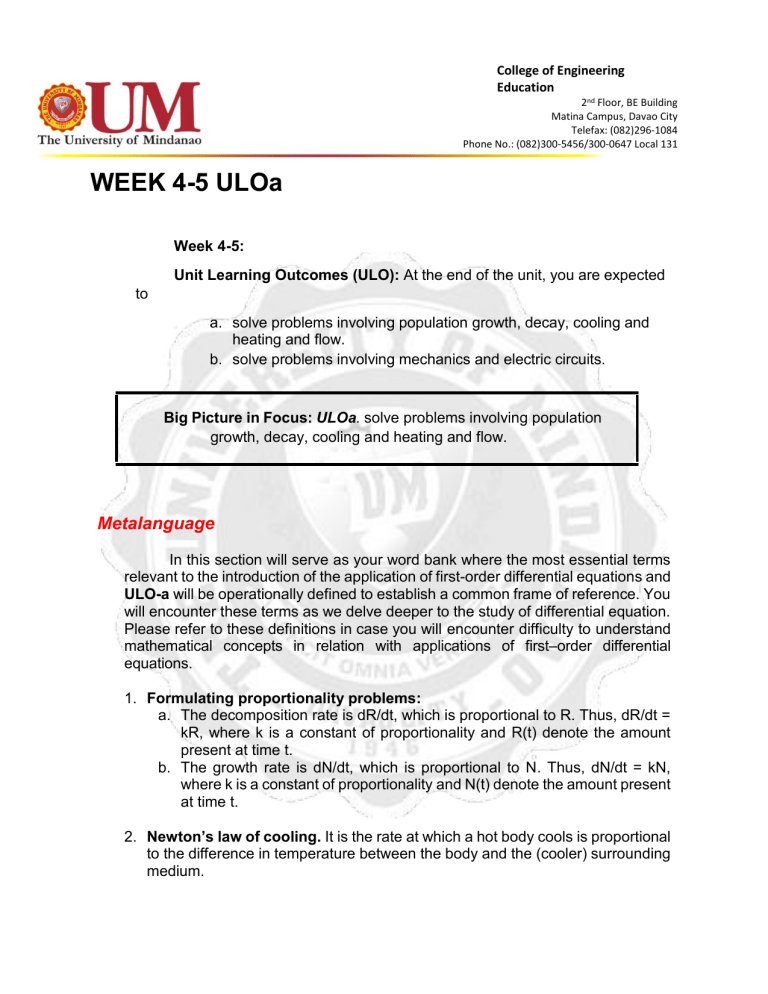
College of Engineering Education 2nd Floor, BE Building Matina Campus, Davao City Telefax: (082)296-1084 Phone No.: (082)300-5456/300-0647 Local 131 WEEK 4-5 ULOa Week 4-5: Unit Learning Outcomes (ULO): At the end of the unit, you are expected to a. solve problems involving population growth, decay, cooling and heating and flow. b. solve problems involving mechanics and electric circuits. Big Picture in Focus: ULOa. solve problems involving population growth, decay, cooling and heating and flow. Metalanguage In this section will serve as your word bank where the most essential terms relevant to the introduction of the application of first-order differential equations and ULO-a will be operationally defined to establish a common frame of reference. You will encounter these terms as we delve deeper to the study of differential equation. Please refer to these definitions in case you will encounter difficulty to understand mathematical concepts in relation with applications of first–order differential equations. 1. Formulating proportionality problems: a. The decomposition rate is dR/dt, which is proportional to R. Thus, dR/dt = kR, where k is a constant of proportionality and R(t) denote the amount present at time t. b. The growth rate is dN/dt, which is proportional to N. Thus, dN/dt = kN, where k is a constant of proportionality and N(t) denote the amount present at time t. 2. Newton’s law of cooling. It is the rate at which a hot body cools is proportional to the difference in temperature between the body and the (cooler) surrounding medium. College of Engineering Education 2nd Floor, BE Building Matina Campus, Davao City Telefax: (082)296-1084 Phone No.: (082)300-5456/300-0647 Local 131 3. Flow problems: It is the time rate of change of dQ/dt, equals the rate at which salt enters the tank minus the rate at which salt leaves the tank. Salt enters the tank at the rate of be lb/min. Please proceed immediately to the “Essential Knowledge” part since the first lesson is also definition of essential terms. Essential Knowledge To perform the aforesaid big picture (unit learning outcomes) for the first three (3) weeks of the course, you need to fully understand the following essential knowledge that will be laid down in the succeeding pages. Please note that you are not limited to exclusively refer to these resources. Thus, you are expected to utilize other books, research articles and other resources that are available in the university’s library (refer to the library contact on page 3). Applications of first- order differential equations a. Population Growth Problems Example 38: A certain population of bacteria is known to grow at a rate proportional to the amount present in a culture that provides plentiful food and space. Initially there are 250 bacteria, and after seven hours 800 bacteria are observed in the culture. Find an expression for the approximate number of bacteria present in the culture at any time t and determine the approximate number of bacteria that will be present in the culture after 24 hours. Solution: Let N = the number of bacteria present dN/dt = the growth rate at any time t dN/dt = kN where, k is a constant of proportionality Using separable College of Engineering Education 2nd Floor, BE Building Matina Campus, Davao City Telefax: (082)296-1084 Phone No.: (082)300-5456/300-0647 Local 131 ∫dN/N = ∫kdt → ln N = kt + c →N = ekt + c = ekt ec = c1ekt where, c1 = ec Therefore, N = c1ekt Applying initial condition At t = 0, we are given N = 250 250 = c1ek(0) → c1= 250 So the solution becomes N = 250ekt At t = 7 hours, we are given N = 800 800 = 250ek(7) k = [ln(800/250)]/7 = 0.166 The particular solution is N = 250e0.166t To determine the approximate number of bacteria present at any time t At t = 24 hours, N = ? N = 250e0.166x24 N = 13,433 Example 39: The population of a certain country is known to increase at a rate proportional to the number of people presently living in the country. If after 2 years the population has doubled, and after 3 years the population is 20,000, find the number of people initially living in the country. Solution: Let N = the number of people present N0 = the number of people initially living in the country dN/dt = the growth rate at any time t dN/dt = kN where, k is a constant of proportionality College of Engineering Education 2nd Floor, BE Building Matina Campus, Davao City Telefax: (082)296-1084 Phone No.: (082)300-5456/300-0647 Local 131 Using separable ∫dN/N = ∫kdt → ln N = kt + c →N = ekt + c = ekt ec = c1ekt where, c1 = ec Therefore, N = c1ekt Applying initial condition At t = 0, we are given N = N0 N0 = c1ek(0) → c1= N0 So the solution becomes N = N0ekt At t = 2, N = 2N0 We get 2N0 = N0e2k →k = 0.347 The solution finally becomes N = N0e0.347t At t = 3, N = 20,000 Therefore, N0 = 7062 the number of people initially living in the country b. Decay Problems Example 40: A certain radioactive material is known to decay at a rate proportional to the amount present. If initially there is 100 mg of the material present and if after 2 years it is observed that 5 percent of the original mass has decayed, find an expression for the mass at any time t and determine the time necessary for 10 per cent of the original mass to decay. Solution: Let N = the number of radioactive material present dN/dt = the decomposition rate at any time t College of Engineering Education 2nd Floor, BE Building Matina Campus, Davao City Telefax: (082)296-1084 Phone No.: (082)300-5456/300-0647 Local 131 dN/dt = kN where, k is a constant of proportionality Using separable ∫dN/N = ∫kdt → ln N = kt + c →N = ekt + c = ekt ec = c1ekt where, c1 = ec Therefore, N = c1ekt Applying initial condition At t = 0, we are given N = 100 100 = c1ek(0)→c1 = 100 So the solution becomes N = 100ekt At t = 2, 5 percent of the original mass of 100 mg, or 5 mg, has decayed N = 100 – 5 = 95 mg We get, 95 = 100e2k →k = [ln(95/100)]/2 = - 0.0256 The amount of radioactive material present at any time t N = 100e – 0.0256t When 10 percent of the original mass to decay N = 100 – 0.1(100) = 90 mg t = ? 90 = 100e – 0.0256t t = 4.12 years Example 41: A certain radioactive material is known to decay at rate proportional to the amount present. If after 1 h it is observed that 10 percent of the material has decayed, find the half-life of the material. Solution: Let N = the amount of the material present at time t. College of Engineering Education 2nd Floor, BE Building Matina Campus, Davao City Telefax: (082)296-1084 Phone No.: (082)300-5456/300-0647 Local 131 N0 = the amount of the material initially present. dN/dt = the decomposition rate at any time t dN/dt = kN where, k is a constant of proportionality Using separable ∫dN/N = ∫kdt → ln N = kt + c →N = ekt + c = ekt ec = c1ekt where, c1 = ec Therefore, N = c1ekt Applying initial condition At t = 0, we are given N = N0 N0 = c1ek(0) → c1= N0 So the solution becomes N = N0ekt At t = 1, 10 percent of the original mass N0 has decayed, so 90 percent remains. Hence N = 0.9N0 0.9N0 = N0ek(1) →k = - 0.105 The solution finally becomes N = N0e – 0.105t When N is half-life N = ½ N0 t = ? Therefore, ½ N0 = N0e – 0.105t t = 6.60 h c. Cooling and Heating Problems Newton’s law of cooling states that the time rate of change of the temperature of a body is proportional to the temperature difference between the body and its surrounding medium. Newton’s law of cooling can be formulated dT/dt = - k(T – Tm) Where T = temperature of the body Tm= temperature of the surrounding medium dT/dt = the time rate of change of the temperature of the body College of Engineering Education 2nd Floor, BE Building Matina Campus, Davao City Telefax: (082)296-1084 Phone No.: (082)300-5456/300-0647 Local 131 k = is a constant of proportionality Example 42: A metal bar at a temperature of 1000F is place in a room at a constant temperature of 00F. If after 20 min the temperature of the bar is 50 0F, find an expression for the temperature of the bar at any time and the time it will take for the bar to reach a temperature of 250F. Solution: Let T = temperature of the body Tm= temperature of the surrounding medium dT/dt = the time rate of change of the temperature of the body k = is a constant of proportionality Using Newton’s law of cooling formula dT/dt = - k(T – Tm) → note: Tm = 00F dT/dt = - k(T – 0) Apply separable ∫dT/T = - ∫kdt Integrating ln T = - kt + c → T = e – kt + c = e – kt ec T = c1e – kt where c1 = ec Apply initial condition at t = 0 T = 1000F 1000F = c1e – k(0) →c1 = 1000F Therefore, T = 100e- kt At t = 20 min T = 500F 50 = 100e- k(20) →k = [ln(50/100)]/-20 = 0.035 The temperature of the bar at any time t T = 100e- 0.035t When T = 25 t = ? 25 = 100e- 0.035t →t = [ln(25/100)]/-0.035 t = 39.6 min. Example 43: A body at an unknown temperature is placed in a room which is held at a constant temperature of 300F. If after 10 min the temperature of the body is 00F and after 20 min the temperature of the body is 150F, find an expression for the temperature of the body at time t and the initial temperature of the body, just as it is placed into the room. College of Engineering Education 2nd Floor, BE Building Matina Campus, Davao City Telefax: (082)296-1084 Phone No.: (082)300-5456/300-0647 Local 131 Solution: Let T = temperature of the body Tm= temperature of the surrounding medium dT/dt = the time rate of change of the temperature of the body k = is a constant of proportionality Using Newton’s law of cooling formula dT/dt = - k(T – Tm) → note: Tm = 300F dT/dt = - k(T – 30) →dT/dt + kT = 30k Apply linear first order D.E. p(t) = k q(t) = 30k Formula: Te∫p(t)dt = ∫e∫p(t)dt q(t)dt + c Te∫(k)dt = ∫e∫(k)dt (30k)dt + c Tekt = ∫ekt(30k)dt + c Tekt = ekt(30k)/k + c T = 30 + ce – kt Apply the condition At t = 10 T = 0 0 = 30 + ce-k(10) →ce-10k = - 30 ……. eqn. 1 At t = 20 T = 15 15 = 30 + ce- 20k →ce-20k = - 15 ……. eqn. 2 Divide eqn. 1 and eqn. 2 ce-10k = - 30 ce-20k - 15 e10k = 2 → k = 0.069 c = - 30e10(0.069) = - 30(2) = -60 Therefore, T = 30 – 60e – 0.069t for the temperature of the body at any time t AT t = 0 T = ? T = 30 – 60e- 0.069(0) T = - 300F d. Flow Problems A tank initially holds V0 gal of brine that contains a lb of salt. Another brine solution, containing b lb of salt per gallon, is poured into the tank at the rate of e gal/min while, simultaneously, the well-stirred solution leaves the tank at the rate of f gal/min. College of Engineering Education 2nd Floor, BE Building Matina Campus, Davao City Telefax: (082)296-1084 Phone No.: (082)300-5456/300-0647 Local 131 Fig. 1 Let Q denote the amount (in pounds) of salt in the tank at any time. The rate of change of Q, dQ/dt, equals the rate at which salt enters the tank minus the rate at which salt leaves the tank. Salt enters the tank at the rate of be lb/min. To determine the rate at which salt leaves the tank, we first calculate the volume of brine in the tank at any time t, which the initial volume V0 plus the volume of brine added et minus the volume of brine removed ft. Thus the volume of brine in the tank at any time is V0 + et – ft. The concentration of salt in the tank at any time is then Q/(V0 + et – ft), from which it follows that salt leaves the tank at the rate of f[Q/(V0 + et – ft)] lb/min. Thus, dQ/dt = be - f[Q/(V0 + et – ft)], so that dQ + f Q = be dt V0 + (e – f)t At t = 0, Q = a, so we also have the initial condition Q(0) = a Example 44: A tank initially holds 100 gal of a brine solution containing 20 lb of salt. At t = 0, fresh water poured into the tank at the rate of 5 gal/min, while the well-stirred mixture leaves the tank at the same rate. Find the amount of salt in the tank at any time t. Solution: Given: V0 = 100, a = 20, b = 0, e = f = 5 Formula: dQ + f Q = be dt V0 + (e – f)t College of Engineering Education 2nd Floor, BE Building Matina Campus, Davao City Telefax: (082)296-1084 Phone No.: (082)300-5456/300-0647 Local 131 dQ/dt + 5Q/[ 100 + (5 – 5)0] = (0)(5) dQ/dt + Q/20 = 0 By separable ∫dQ/Q = - ∫dt/20 lnQ = - t/20 + c → Q = e- t/20 + c = e- t/20 ec Q = c1e- t/20 Apply initial condition At t = 0 Q = a = 20 20 = c1e- (0)/20 →c1 = 20 Therefore, Q = 20e – t/20 Example 45: A 50-gal tank initially contains 10 gal of fresh water. At t = 0, a brine solution containing 1 lb of salt per gallon is poured into the tank at the rate of 4 gal/min, while the well-stirred mixture leaves the tank at the rate of 2 gal/min. Find the amount of time required for overflow to occur and the amount of salt in the tank at the moment of overflow. Solution: Given: V0 = 10, a = 0, b = 1, e = 4, f = 2 From the volume of brine in the tank at any time is V0 + et – ft = 10 + 4t – 2t = 10 + 2t IF we required t when overflow to occur. Therefore, 10 + 2t = 50 → t = 20 min. If we asked the amount of salt in the tank at the moment of overflow Formula: dQ + f Q = be dt V0 + (e – f)t dQ/dt + 2Q/[ 10 + (4 –2)t] = (1)(4) dQ/dt + 2Q/(10 + 2t) = 4 By linear differential equation p(t) = 2/(10 + 2t) q(t) = 4 ∫p(t)dt Formula: Qe = ∫e∫p(t)dt q(t)dt + c ∫2dt/(10 + 2t) ∫2dt/(10 + 2t) (4)dt + c Qe = ∫e Integrating, Qeln(10 + 2t) = ∫eln(10 + 2t) (4)dt + c note: eln(10 + 2t) = Ι10 + 2tǀ Q(10 + 2t) = ∫(10 + 2t)(4)dt + c = 40t + 4t2 + c Simplifying, College of Engineering Education 2nd Floor, BE Building Matina Campus, Davao City Telefax: (082)296-1084 Phone No.: (082)300-5456/300-0647 Local 131 Q= (40t + 4t2 + c)/(10 + 2t) Apply the initial condition At t = 0, Q = a = 0 0 = [40(0) + 4(0)2 + c]/[10 + 2(0)] c=0 Q = (40t + 4t2)/(10 + 2t) If we required Q at the moment of overflow, which t = 20 Q = [40(20) + 4(20)2]/[10 + 2(20)] Q = 48 lb. Self-Help: You can refer to the sources below to help you further understand the lesson Ferland, K. (2009). Differential Equation. Hougton Mifflin. DuChateau, P. & Zachmann D. (2011), Schaum’s of Partrial Differential Equations (3rd Edition). New York: McGraw-Hill. Dobrushkin, V. A. (2015). Applied Differential Equations: the primary course, CRC Press. Strauss, W. (2008). Partial Differential Equation: an Introduction, John Willey & Sons. Let's Check Activity4: Since you are now armed with basic knowledge to solve problems involving population growth, decay, cooling and heating and flow, it is now your turn to prove what you have learned in the previous discussion. Solve the following problems. a). Population growth problems 1. A bacteria culture is known to grow at a rate proportional to the amount present. After one hour, 1000 bacteria are observed in the culture; and after four hours, 3000. Determine the number of bacteria originally in the culture. Ans.: 694 College of Engineering Education 2nd Floor, BE Building Matina Campus, Davao City Telefax: (082)296-1084 Phone No.: (082)300-5456/300-0647 Local 131 2. A bacteria culture is known to grow at a rate proportional to the amount present. Find an expression for the approximate number of bacteria in such a culture if the initial number is 300 and if it is observed that the population has increased by 20 percent after 2 h. Ans.: 300e0.09116t; 2675 b). Decay problems 1. A certain radioactive material is known to decay at a rate proportional to the amount present. If initially there is 50 mg of the material present and after 2 h it is observed that the material has lost 10 percent of its original mass, determine the mass of the material after 4 h. Ans.: 40.5 mg 2. Radium decomposes at a rate proportional to the amount present. If half the original amount disappears in 1600 years, find the percentage lost in 100 years. Ans.: 4.2 percent c). Cooling and heating problems 1. A body at a temperature of 500F is placed outdoors where the temperature is 1000F. If after 5 min the temperature of the body is 60 0F, determine how long it will take the body to reach a temperature of 75 0F. Ans.: 15.4 min 2. A body at a temperature of 00F is placed in a room whose temperature is kept at 1000F. If after 10 min the temperature of the body is 250F, find the time needed for the body to reach a temperature of 500F. Ans.: 24.1 min. d). Flow problems 1. A tank initially holds 100 gal of a brine solution containing 1 lb of salt. At t = 0 another brine solution containing 1 lb of salt per gallon is poured into the tank at the rate of 3 gal/min, while the well-stirred mixture leaves the tank at the same rate. Find the time at which the mixture contains 2 lb of salt. Ans.:0.338 min. 2. A tank initially holds 10 gal of fresh water. At t = 0, a brine solution containing ½ lb of salt per gallon is poured into the tank at a rate of 2 gal/min, while the well-stirred mixture leaves the tank at the same rate. Find the amount of salt in the tank at any time t. Ans.: - 5e-t/5 + 5 College of Engineering Education 2nd Floor, BE Building Matina Campus, Davao City Telefax: (082)296-1084 Phone No.: (082)300-5456/300-0647 Local 131 Let's Analyze Activity 4. Getting acquainted with the problems involving population growth, decay, cooling and heating and flow is not enough. This time shows the concepts of the applications of first-order differential equations again and explains its step-by-step procedure. Solve the following problems. a). Population growth problems 1. A certain culture of bacteria grows at a rate that is proportional to the number present. If it is found that the number doubles in 4 h, how many may be expected at the end of 12 h? Ans.: 8x0 2. In a culture of yeast the amount of active ferment grows at a rate proportional to the amount present. If the amount doubles in 1 h, how many times the original amount may be anticipated at the end of 2.75 h? Ans.: 6.72N0 b). Decay problems 1. A certain radioactive material is known to decay at a rate proportional to the amount present. If initially ½ g of the material is present and 0.1 percent of the original mass has decayed after 1 week, determine the half-life of the material. Ans.: 693 weeks 2. A certain radioactive material is known to decay at a rate proportional to the amount present. If initially 500 mg of the material is present and after 3 years 20 percent of the original mass has decayed, determine the amount remaining after 25 years. Ans.: 77.9 mg c). Cooling and heating problems 1. A body at a temperature of 500F is placed in an oven whose temperature is kept at 1500F. if after 10 min the temperature of the body is 750F, find the time required to reach a temperature 1000F. Ans.: 24.1 min 2. A body whose temperature is initially 1000C is allowed to cool in air whose temperature remains at a constant 200C. Find a formula which gives the temperature of the body as a function of time t if it is observed that after 10 min the body has cooled to 400C. Ans. 20 + 80e- 0.1386t d). Flow problems College of Engineering Education 2nd Floor, BE Building Matina Campus, Davao City Telefax: (082)296-1084 Phone No.: (082)300-5456/300-0647 Local 131 1. A tank initially holds 80 gal of a brine solution containing 1/8 lb of salt per gal. At t = 0, another brine solution containing 1 lb of salt per gallon is poured into the tank at the rate of 4 gal/min, while the well-stirred mixture leaves the tank at the rate of 8 gal/min. Find the amount the amount of salt in the tank when the tank contains exactly 40 gal of brine. Ans.: 22.5 lb 2. A tank contains 100 gal of brine made by dissolving 80 lb of salt in water. Pure water runs into the tank at the rate of 4 gal/min, and the mixture, kept uniform by stirring, runs out at the same rate. Find the amount of salt in the tank at any time t. Ans.: 80e- 0.04t In a Nutshell We are now done with the generalization and concept of first-order D.E. which exploring and understanding the application of first-order differential equation. Before proceeding to the next unit learning outcomes, be reminded of some important points when dealing with application of first-order differential equations. A certain population of bacteria is known to grow at a rate proportional to the amount present. A certain radioactive material is known to decay at a rate proportional to the amount present. Newton’s law of cooling states that the time rate of change of the temperature of a body is proportional to the temperature difference between the body and its surrounding medium. The time rate of change of Q, dQ/dt, equals the rate at which salt enters the tank minus the rate at which salt leaves the tank. The volume of brine in the tank at any time is V0 + et – ft. Q & A-List If you have any questions regarding application first-order differential equation, kindly write down on the table provided. QUESTIONS ANSWERS College of Engineering Education 2nd Floor, BE Building Matina Campus, Davao City Telefax: (082)296-1084 Phone No.: (082)300-5456/300-0647 Local 131 1. 2. 3. 4. 5. Key Words Index: Population growth, proportional, decompose, Newton’s law of cooling and heating, medium, time rate of change, brine solution and concentration of salt.
